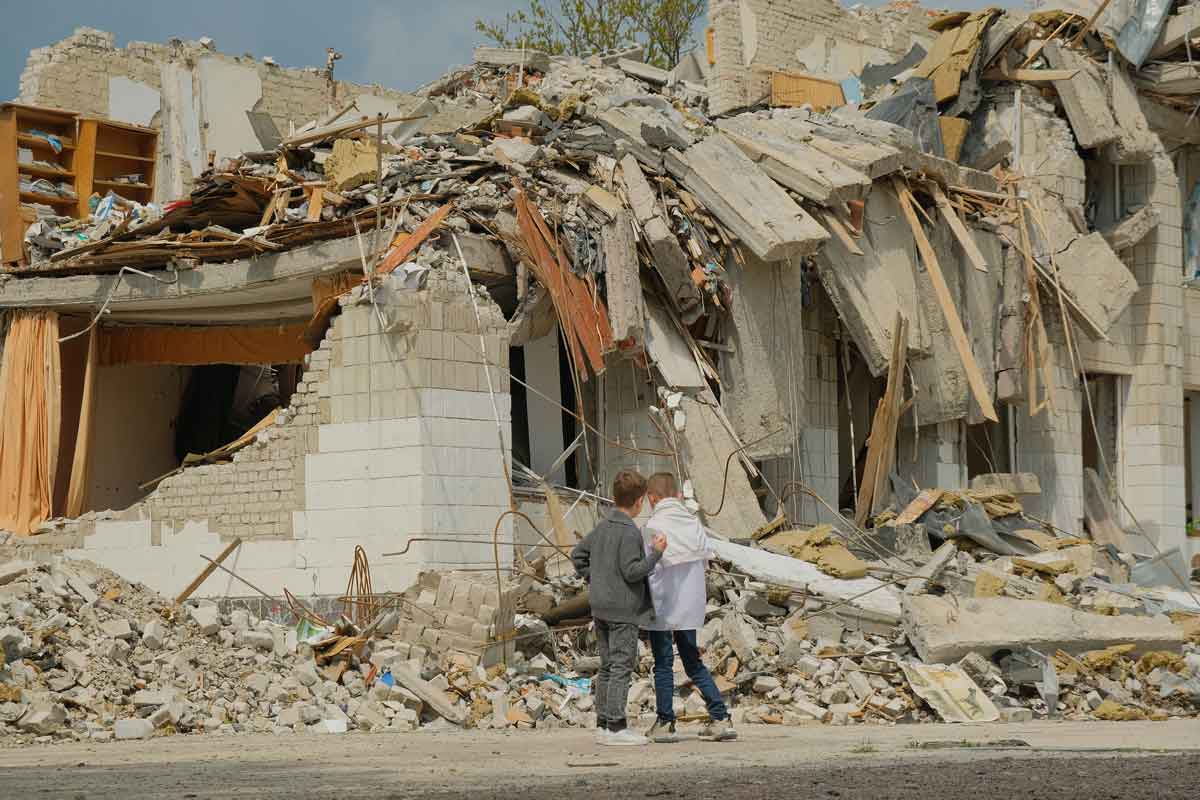The devastating impact of war on antimicrobial resistance
Armed conflict is fuelling the global spread of antimicrobial resistance. We spoke to CDC’s Ukraine Country Director to find out just how dangerous this could be.
- 19 September 2024
- 7 min read
- by Linda Geddes

War kills, injures and traumatises in many ways. Not everyone is lucky enough to make it to a hospital to receive treatment, and if they do, they may find its wards and corridors packed with soldiers and civilians requiring treatment for infected open wounds, malnutrition or the ongoing psychological stress of living in a conflict zone.
Increasingly though, they face another looming threat: the possibility of picking up an antimicrobial resistant infection that places their health in further jeopardy.
Globally, antimicrobial resistance (AMR) already contributes to some 5 million deaths each year and is rising at an alarming rate.
“In the chaos of war, where medical professionals face overwhelming numbers of casualties and limited resources, broad-spectrum antibiotics are sometimes administered to stabilise patients quickly, though this poses a significant risk of contributing to antimicrobial resistance.”
- Dr Ezra Barzilay, Country Director for the US Centers for Disease Control and Prevention’s (CDC’s) office in Ukraine
While the overuse and inappropriate application of antibiotics in medicine and agriculture are major contributing factors, there’s growing recognition of the role that armed conflict is playing in fuelling the spread of drug-resistant infections.
With little hope of a world without war anytime soon, health leaders are increasingly asking themselves what to do about it.
Drug-resistant infections
Antimicrobial resistance occurs when bacteria, fungi or viruses develop genetic changes that enable them to survive drugs or other antimicrobials that previously would have killed them.
Its emergence threatens many hard-won medical gains made over the past century, making it riskier to perform routine procedures and rendering infections more difficult to treat.
War may contribute to this problem in several ways. Firstly, wounds sustained on the battlefield tend to be dirty injuries, embedded with soil or contaminants that increase the risk of infection occurring.
The weapons and explosives that caused them may also have introduced toxic heavy metals into the wound, which places further pressure on microbes to evolve survival mechanisms to overcome them.
“Infection also doesn't respect borders, regardless of war, and we’ve seen reports from hospitals across Europe and Japan which received patients from Ukraine, that have identified bacteria carrying resistance patterns that had not previously been seen, or that are of a highly resistant calibre.”
- Dr Ezra Barzilay, Country Director for the US Centers for Disease Control and Prevention’s (CDC’s) office in Ukraine
Both battles and aerial bombardment also have the potential to create lots of casualties within a short space of time, many of whom may require immediate treatment, yet interruption to the health system – whether through direct attacks on hospitals, energy infrastructure, or health care workers being repositioned to meet other needs – hinders treatment options.
“Usually, we would want to treat such people with antibiotics, but [to reduce the risk of antimicrobial resistance developing] it is important to consider the choice of drugs, the frequency, and when and where they are used,” says Dr Ezra Barzilay, Country Director for the US Centers for Disease Control and Prevention’s (CDC’s) office in Ukraine.
Particularly in mass-casualty situations, this may be impractical, while proper disinfection of hands, surfaces and equipment may also be difficult to achieve.
"In the chaos of war, where medical professionals face overwhelming numbers of casualties and limited resources, broad-spectrum antibiotics are sometimes administered to stabilise patients quickly, though this poses a significant risk of contributing to antimicrobial resistance,” says Barzilay.

Adapt and survive
Effective as broad-spectrum drugs are, they may promote the sharing of resistance genes between microbial communities; select for the growth of bacteria that are already resistant to the antibiotic; and, by indiscriminately killing both harmful and beneficial microbes, create the physical space within wounds or organs for resistant organisms to grow and flourish.
In settings where access to, and resources within the health care system are limited, these resistant infections can then easily spread from person to person.
Conflict can also contribute to their wider geographical dissemination. Bed shortages may result in patients being transferred to other parts of the country, where hospitals may also be under severe strain, meaning standard infection prevention and control procedures aren’t strictly followed.
Ideally, people with antimicrobial resistant infections would be separated from other patients, but in such circumstances this may not be possible, or the facilities to test for such infections may be lacking.
Ukraine conflict
This is of particular concern in countries such as Ukraine, where generally poor awareness about the importance of antimicrobial stewardship among health care workers had led to high levels of antimicrobial resistance in the community, even before the start of the ongoing conflict with Russia.
This high starting point, combined with large numbers of injured patients, and their transfer to medical facilities in other regions of Ukraine and abroad, has created a “perfect storm” for the dissemination of antimicrobial resistant infections, Barzilay says.
Several studies have documented an increased incidence of antimicrobial resistance among Ukrainian soldiers and civilian patients since the start of the war with Russia.
One study, which reported on 141 patients requiring emergency surgery for burns, fractures and shrapnel wounds, found that at least half of isolates from these patients were resistant to at least one antibiotic, while 6% of isolates – all Klebsiella pneumoniae, a common cause of hospital-acquired pneumonia – were resistant to every antimicrobial tested.
“A severe shortage of medical professionals puts further strain on already exhausted staff who prioritise limb-saving and life-saving procedures over infection and antimicrobial resistance prevention.”
- Dr Krystel Moussally at Médicins Sans Frontières’ Middle East Medical Unit
Other studies have documented high levels of bacteria carrying a specific enzyme, called New Delhi metallo-β-lactamase, and/or a mutation known as OXA-48 among refugees and war-wounded Ukrainians – both of which confer resistance against a wide range of commonly-used antibiotics.
“There are clear signals that antimicrobial resistance is worsening since the war, and has gone up fairly steeply,” says Barzilay.
“Infection also doesn't respect borders, regardless of war, and we’ve seen reports from hospitals across Europe and Japan which received patients from Ukraine, that have identified bacteria carrying resistance patterns that had not previously been seen, or that are of a highly resistant calibre.”
For instance, a recent microbiological survey conducted in Germany identified an increase in K. pneumoniae carrying New Delhi metallo-β-lactamase or OXA-48 mutations among Ukrainian refugees and soldiers.
Iraqibacter
Neither is this issue restricted to the war in Ukraine. Antoine Abou Fayed at the American University of Beirut in Lebanon and his colleagues recently reviewed studies documenting the emergence and spread of bacteria with specific antibiotic resistance patterns in Iraq, in association with the 2003–2011 Iraq War and subsequent conflicts with ISIS militants.
One such organism is Acinetobacter baumannii, a cause of blood, urinary tract, lung and wound infections in hospital settings. “Resistant A. Baumannii is now of growing global concern, having gained the moniker ‘Iraqibacter’ following its spectacular rise as a resistant [hospital-acquired] pathogen in Iraq," Fayed said.
The conflict in Gaza could provide yet another flashpoint. In late 2023, Dr Krystel Moussally at Médicins Sans Frontières’ Middle East Medical Unit and colleagues published a commentary in The Lancet, warning of rising rates of antibiotic resistance in Gaza, which are being compounded by the ongoing conflict.
They explained that the destruction of hospitals and collapse of health care infrastructure has led to heavily contaminated wounds not being operated on as frequently as needed to prevent infection: “A severe shortage of medical professionals puts further strain on already exhausted staff who prioritise limb-saving and life-saving procedures over infection and antimicrobial resistance prevention,” Moussally added.
“Moreover, critical shortages in basic medical equipment and essential antibiotics, along with chaos, destruction, and dysfunctional microbiological laboratories, make implementing antimicrobial stewardship an unattainable luxury.”
Have you read?
Infection control
So, what to do about it? In Ukraine, the CDC has been collaborating with the Center for Public Health of the Ministry of Health of Ukraine, local clinical and public health authorities, and international partners to improve laboratory detection, clinical treatment, and infection control responses in several regions of the country.
“We are also providing central reference laboratories with modern lab equipment, training on how to integrate this into their regular workflow and working with partners to implement improvement plans for patient flow within hospitals and create these invisible barriers that prevent patients from colonising each other,” says Barzilay.
“We are also working at the policy level to ensure that appropriate use guidelines [for antibiotics] are being communicated and enforced across the civilian health sector and ministries of health and of defence.”
The World Health Organization has recognised antimicrobial resistance as one of the top global public health and development threats. While health workers may be powerless to prevent wars from occurring, such measures could at least help reduce the devastation that trails in their wake.







